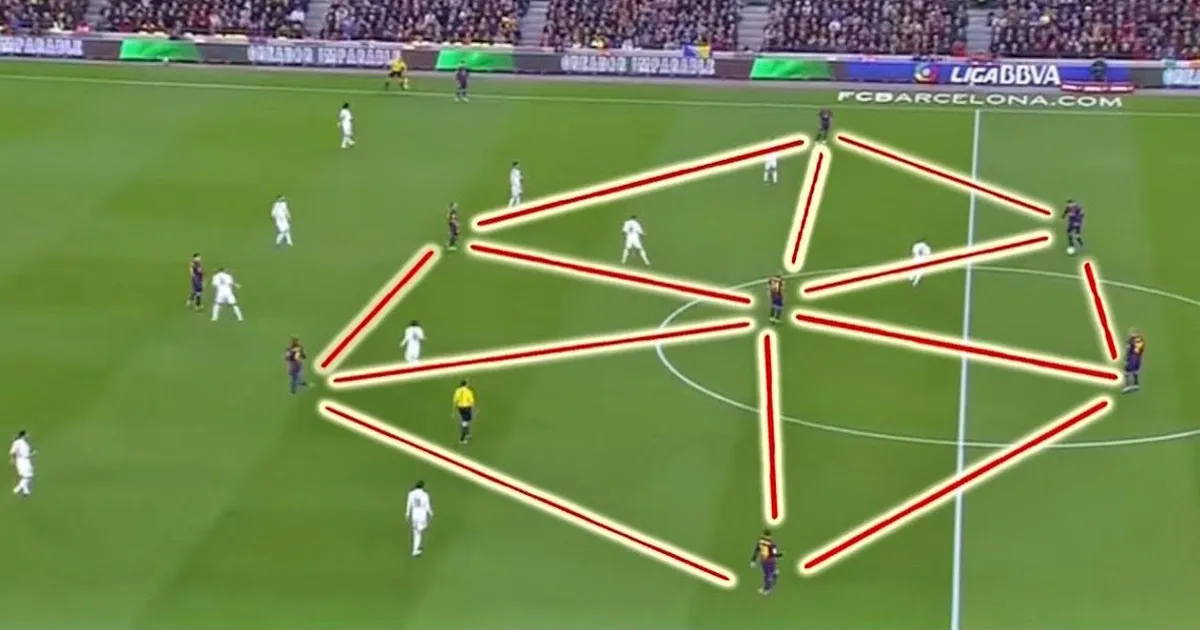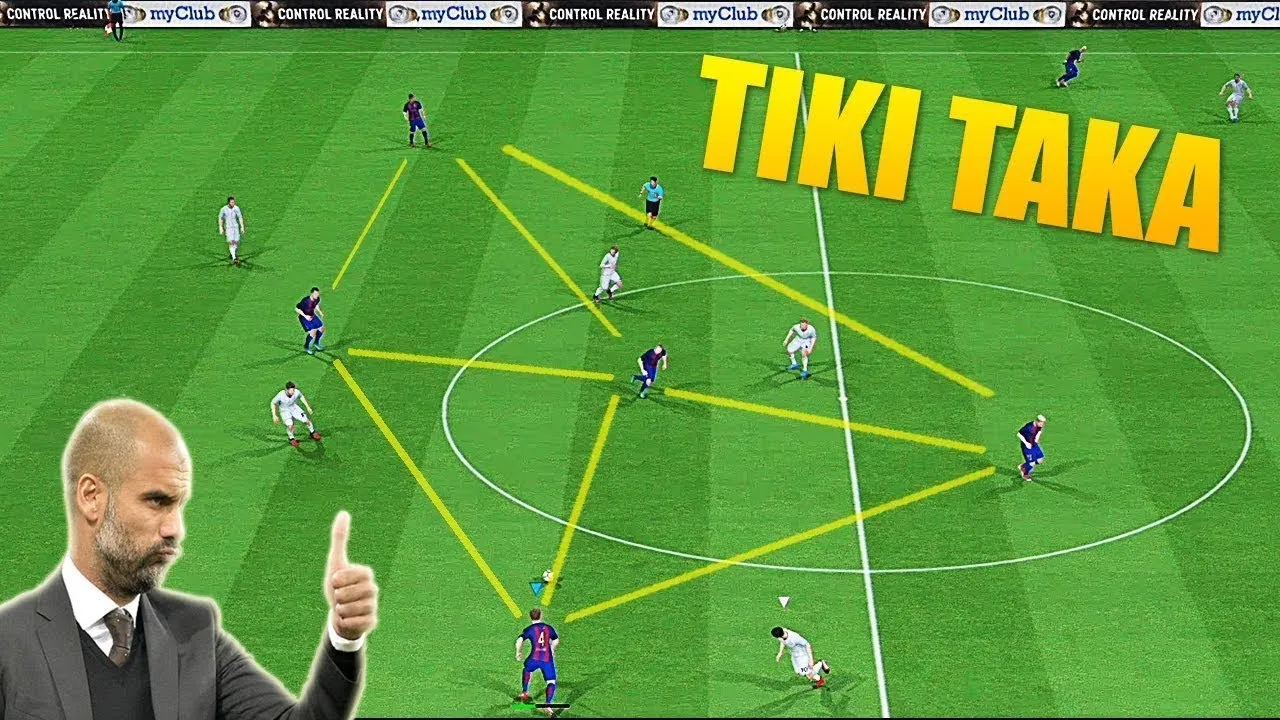
The beautiful game of football has undergone a significant evolution over the years. With each passing generation, tactics and strategies have evolved, leading to the emergence of new styles of play. One such style that has captured the hearts of football enthusiasts around the world is the famous Tiki-Taka.
Tiki-Taka, a term popularized by Spanish giants Barcelona, refers to a possession-oriented style of play that relies on short, quick passes to control the ball and dominate the opposition. It has become synonymous with teams that prioritize fluid movement, intricate passing, and relentless pressing to create scoring opportunities.
In this comprehensive guide, we will delve into the intricacies of Tiki-Taka, its origins, its key components, and how you can master it to elevate your team’s game. Whether you are a player, coach, or simply a fan looking to understand this mesmerizing style of play, this article will provide you with all the information you need. So without further ado, let’s dive into the world of Tiki-Taka.

What is Tiki-Taka?
Tiki-Taka, a term derived from the Spanish word “tiqui-taca,” which loosely translates to “tap-tap,” is an intricately designed style of play that emphasizes quick, short passes to maintain possession of the ball. This possession-oriented style of play was popularized by Spanish giants Barcelona, who won numerous major titles employing this mesmerizing tactic.
The concept of Tiki-Taka revolves around maintaining control of the ball and utilizing it to create scoring opportunities. It prioritizes fluid movement and precise passing over individual brilliance, making it an ideal style for teams that possess technically gifted players. With the right execution, Tiki-Taka can be used to dominate the opposition and create a relentless attacking threat.
Origins of Tiki-Taka
While Tiki-Taka rose to prominence with Barcelona’s success under Pep Guardiola in the late 2000s, its roots can be traced back to Dutch football in the 1970s. The renowned Total Football philosophy, introduced by Rinus Michels and perfected by Johan Cruyff, emphasized fluid movement, positional interchange, and quick passing to outplay opponents.
The principles of Total Football were further developed by Cruyff during his time as a player and coach at Barcelona. He implemented a similar style of play, which was later referred to as “Cruyffball,” that laid the foundation for Tiki-Taka. However, it wasn’t until Guardiola’s reign at Barcelona that Tiki-Taka gained global recognition and became synonymous with possession football.
Famous teams and players associated with Tiki-Taka
Barcelona’s dominance in Spain and Europe from 2008-2012 under Guardiola showcased the true potential of Tiki-Taka. Led by the midfield trio of Xavi, Andres Iniesta, and Sergio Busquets, along with the dazzling skills of Lionel Messi upfront, Barcelona mesmerized fans and opponents alike with their intricate passing and fluid movement.
In addition to Barcelona, the Spanish national team also achieved great success using Tiki-Taka, winning back-to-back European Championships in 2008 and 2012, as well as the 2010 FIFA World Cup. The likes of Xavi, Iniesta, and Busquets were instrumental in Spain’s success, along with other talented players such as David Silva, Cesc Fabregas, and Sergio Ramos.
In recent years, other teams have also adopted the Tiki-Taka style, including Bayern Munich, Manchester City, and Chelsea. Players like Kevin De Bruyne, Thiago Alcantara, and Jorginho have excelled in these systems, showcasing the versatility and effectiveness of Tiki-Taka.
The Key Components of Tiki-Taka

Tiki-Taka is a complex style of play that relies on several key components working together seamlessly. Let’s take a closer look at what makes this style so unique and effective:
Possession-oriented mindset
The most crucial aspect of Tiki-Taka is having a possession-oriented mindset. This means prioritizing ball retention over all else and constantly looking for opportunities to maintain or regain possession. Players must have the confidence and composure to receive and protect the ball, even under pressure, to keep the opposition chasing shadows.
Quick, short passes
Tiki-Taka is all about quick, short passes. Players must be comfortable playing one or two-touch football, constantly moving the ball and retaining possession. Quick passing can also help draw out the opposition and create gaps in their defensive structure, allowing for easier penetration.
Constant movement and support
Movement and support are the building blocks of Tiki-Taka. Players must be continuously moving off the ball, creating passing options and overloading areas on the field. This fluidity and interchangeability of positions confuse the opposition and make it difficult for them to mark players effectively.
Additionally, players must provide support to their teammates by making themselves available for a pass when a teammate is under pressure. This constant movement and support are what makes Tiki-Taka so visually appealing and effective.
High pressing and defensive organization
While Tiki-Taka is mostly known for its attacking prowess, it’s equally important to have a solid defensive foundation. High pressing, where players aggressively close down the opposition to win back possession, is a crucial aspect of this style. It requires immense physical fitness and coordination among players to execute effectively.
However, high pressing alone is not enough. The team must also be well organized defensively to avoid being caught out of position and vulnerable to counter-attacks.
Amalgamation of individual talent and team chemistry
As mentioned earlier, Tiki-Taka relies heavily on individual talent as well as team chemistry. It takes players with exceptional technical abilities, vision, and decision-making skills to pull off this style effectively. At the same time, team chemistry is vital as players must understand each other’s movements and passing preferences to maintain fluidity and continuity in their play.
Mastering Tiki-Taka: Training and Drills
Now that we have a good understanding of the key components of Tiki-Taka, let’s explore some training and drills that can help you master this style of play:
Ball control and passing drills
Possession is the cornerstone of Tiki-Taka, making ball control and passing crucial skills to master. A great way to improve these skills is through drills such as “piggy in the middle,” where players must pass the ball around while one player in the middle tries to intercept.
Other drills like “rondos” or “two-touch keep away” are also effective for improving ball control and quick passing. These drills require players to constantly move and support each other while maintaining possession of the ball.
Positioning and movement exercises
As mentioned earlier, constant movement and support are essential aspects of Tiki-Taka. To improve these skills, coaches can use exercises like “the square,” where players must constantly move and switch positions within a designated area while keeping possession of the ball.
Another helpful exercise is the “triangle drill,” where players must pass and move in triangular patterns to maintain possession. This drill helps players develop an understanding of how to create passing options and overload areas on the field.
Small-sided games
Small-sided games are an excellent way to replicate game-like situations and practice Tiki-Taka in a realistic setting. The reduced number of players on a smaller field allows for more involvement and quicker decision-making, essential components of Tiki-Taka.
These games can also be modified to focus on specific aspects of Tiki-Taka, such as high pressing or quick passing. Coaches can also introduce constraints, such as limiting the number of touches or requiring a certain number of passes before a goal can be scored, to encourage players to use Tiki-Taka principles.
Adapting Tiki-Taka to Different Systems and Players

While Tiki-Taka is often associated with a 4-3-3 formation, it can be adapted to suit different systems and players. Here are a few examples:
Implementing Tiki-Taka in a 4-3-3 formation
The 4-3-3 formation is the most commonly associated system with Tiki-Taka. In this formation, the three midfielders play a crucial role in maintaining possession and creating attacking opportunities. The wide forwards provide width and stretch the opposition’s defense, while the central forward (the “false nine”) drops deep to receive the ball and create space for other players to make runs into.
Tiki-Taka with a target man in a 4-2-3-1 formation
In a 4-2-3-1 formation, the two central midfielders play a vital role in controlling the midfield and dictating the tempo of the game. The attacking midfielder behind the striker acts as the creative hub, while the wide players provide support and create overloads on the flanks. A tall, physical target man upfront can act as a focal point for quick, short passes, making it easier to penetrate the opposition’s defensive line.
Adjusting to players’ strengths and weaknesses
While Tiki-Taka relies heavily on the collective abilities of the team, coaches must also adjust their tactics based on individual players’ strengths and weaknesses. For example, if a player lacks the technical ability to play quick, short passes, they can be utilized as a more direct option, either through long balls or dribbling at the opposition’s defense.
The Advantages of Tiki-Taka
Tiki-Taka offers several advantages that make it a popular and effective style of play. Let’s take a look at some of these benefits:
Controlling the game and dictating the tempo
Possession-based football allows teams to control the game and dictate the tempo. By keeping hold of the ball and moving it quickly, teams can force the opposition to expend more energy chasing after the ball, making it difficult for them to launch counter-attacks or create scoring opportunities.
Fatiguing the opposition
As mentioned earlier, Tiki-Taka requires immense physical fitness and coordination from players. As the game goes on, the constant movement and pressing can wear down the opposition both physically and mentally. This fatigue can lead to lapses in concentration and mistakes, which Tiki-Taka teams can capitalize on.
Creating scoring opportunities
While Tiki-Taka is often associated with possession and controlling the game, its ultimate aim is to create scoring opportunities. The quick, short passes, constant movement, and overloads created by this style can open up spaces in the opposition’s defense, allowing for more scoring opportunities.
The Limitations of Tiki-Taka

While Tiki-Taka offers several advantages, there are also some limitations that must be considered. Let’s take a look at a few of these:
Vulnerability to counter-attacks
One of the major drawbacks of playing Tiki-Taka is its vulnerability to counter-attacks. With so many players pushing forward and committing to attack, Tiki-Taka teams can be caught out of position if they lose possession in dangerous areas. This makes it crucial for the team to have a solid defensive foundation and be well organized when transitioning from attack to defense.
High level of technical and physical demands
Tiki-Taka is a highly demanding style of play that requires players to possess exceptional technical ability, fitness, and coordination. Not all players are suited for this style, and coaches must carefully select and train players who can execute Tiki-Taka effectively.
Prone to breaking down against defensively organized teams
Teams that employ a low block defense, where they sit deep and compact in their own half, can make it challenging for Tiki-Taka teams to break them down. Without space to exploit and room to move the ball quickly, Tiki-Taka can become predictable and ineffective against defensively organized teams.
Conclusion
Tiki-Taka is a mesmerizing style of play that has captured the hearts of football enthusiasts around the world. Its fluid movement, quick passing, and relentless pressing have made it one of the most effective and visually appealing tactics in modern football. As we have seen in this comprehensive guide, mastering Tiki-Taka requires a combination of individual talent, team chemistry, and tactical understanding.
We hope this article has provided you with a deeper understanding of Tiki-Taka and how you can implement it in your own game. Whether you are a player looking to improve your skills or a coach trying to incorporate Tiki-Taka into your team’s system, remember that practice, patience, and perseverance are key to mastering this beautiful style of play. So go out there and conquer the possession game with Tiki-Taka!


